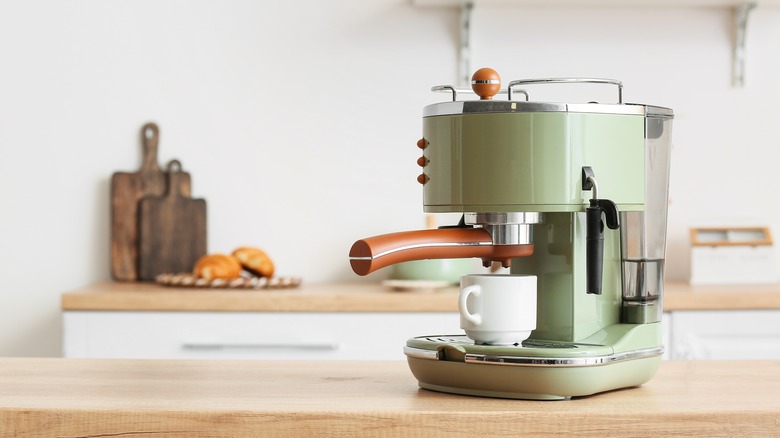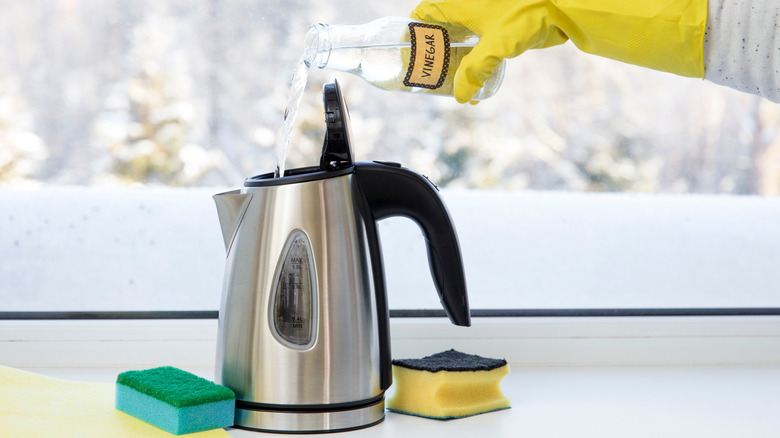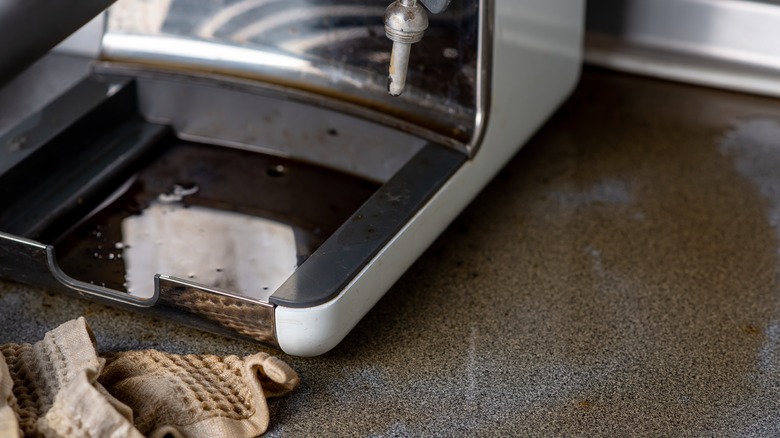If You Want A Better Tasting Home Coffee, Clean Your Coffee Maker
Everyone has a personal preference when it comes to their morning cup of coffee. Most enjoy it with cream and sugar, while others prefer it straight-up. Some even require it to be brewed with an entire crushed egg before that first sip, such as in Scandinavian egg coffee. But perhaps the most unconventional is a high concentration of harmful bacteria. Unfortunately, you've probably been sipping on it for a while now.
We get it — spring cleaning can get the best of us. Washing baseboards, dusting air vents, and donating old clothes from your closet can be demanding work. So, who's to blame you for putting off thoroughly cleaning your coffee machine? After all, the hot water does the job for you, right? Not exactly. In a summarized report of a 2015 study, Caffe Nu analyzed varying levels of bacteria detected in dirty coffee machines. Among the most prevalent were Pseudomonas, Enterococcus, mold, and yeast. These strains are known to inflict harm on our physical health, such as urinary tract and stomach infections. In total, there were 67 bacterial variants found within nine Nespresso and Krup machines.
Mineral and dirt buildup can also obstruct your coffee companion's natural flow, causing it to brew inefficiently with a less-than-desirable taste. So, what's the best way to combat those nasty traces of bacteria and get the most out of our morning cup of joe? All you need is vinegar and water.
Vinegar and water can make your coffee machine good as new
The most effective way to clean your coffee maker actually doesn't require much cleaning at all. First, fill your reservoir with water and vinegar; depending on how dirty it is, you may need to fill it solely with vinegar. Then, just hit brew. The hot water-vinegar mixture will naturally disinfect your machine and remove mineral deposits, leaving you with an unclogged, freshly cleaned coffee maker. However, this takes some time, so allow your device to rest before taking it apart to clean and wash the attachments. Once it has been put back together, run the machine a few times with fresh water to remove any residual vinegar smells or tastes. This method can be used for both drip and single-serve coffee machines.
Baking soda is another strong aid when cleaning coffee makers. If you find your machine has never had an adequate rinse-through, it may be time to call for some baking soda backup. Fill your reservoir with warm water and around 1/4 cup of baking soda before brewing. Filter fresh water twice more and enjoy. Baking soda can also be used to scrub off grime within attachable pieces.
Lastly, lemons can be the perfect solution for freshening your coffee maker. Run one cup of pure lemon juice or lemon concentrate through your machine to remove harmful bacteria and buildup. Follow with a few water cycles, and your device should be as good as new.
Signs it may be time to replace your coffee machine
A best practice is to follow a monthly cleaning schedule for your coffee machine. This will keep the device's passageways from becoming clogged and polluted. However, if your machine has begun leaking or your coffee tastes burnt, it may be time for a new one.
Nothing can escape the circle of life — not even your coffee machine. A general rule of thumb is that these kitchen devices can last anywhere from 5 to 10 years. Tell-tale signs, such as unpleasant smells, lack of pressure or steam, and broken seals, can indicate that something is wrong with Mr. Coffee and it's time for something new. But which route should you take: drip machines or single-use coffee makers?
While K-cup machines are perfect for brewing a single cup rather than an entire batch, they still promote wastage. These cups can only be used once before they are taken to landfills. Drip coffee machines are similarly wasteful. These devices tend to produce large batches of coffee that, in the end, are often thrown out. They also waste energy when kept warm throughout the day. Enter hidden option three: no coffee maker. Yes, pour-over coffee can be an easy, no-waste solution to your early morning necessities. All you'll need is a kettle, filter, dripper, and coffee grounds. Once the water has been boiled, place your dripper over the cup (with a filter and grounds inside) and pour the hot water in.


